
Ducati Diavel Service Manual: Refitting the steering head components
Important
The steering tube bearings (6) are identical but in no case may their components be swapped around during reassembly.
Clean all contact surfaces and lubricate with the recommended grease.
To fit the external rings (c) of the bearings (6) to the steering tube, use the tool with part no. 88713.1062 And proceed as follows:
- Heat the steering head to 150 C;
- Fit the outer races (c) in their seats on the steering head;
- Fit the fixed bush (g, with threaded hole) of the tool into the lower race;
- Fit the other movable bush (h) into the upper end of the tool and drive it fully home against the upper bearing race;
- Tighten the nut (l) and use a wrench to seat the outer races (c) fully in the steering head;
- Leave the tool assembled until the steering head has cooled down to ensure that bearings are properly seated.

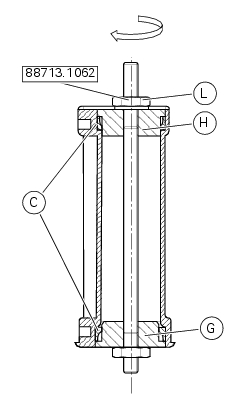
Insert the washer (13), seal (8) (with the rim facing upwards) and inner ring (l) of bottom bearing (6) onto the steering shaft after heating it for about 10 minutes to 120C.
Insert drift part no. 88713.1072 Onto steering shaft. Push the inner ring (l) on the sealing ring (8), manually pushing for at least 10-15 seconds.
Lubricate the inner bearing race (l) with the recommended grease.
Fit the ball race (m) on the steering shaft with the smaller diameter of the cage facing upwards and grease the ball race.
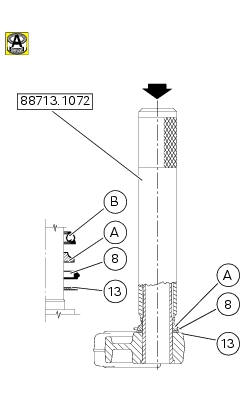
Insert the steering shaft in steering head and push it in until it is axially seated.
Fit the bottom yoke assembly to frame.
Grease the ball race (b) and fit it to frame top outer race (c).
Fit the inner ring (a) of the upper bearing (6) to the steering head, with the larger diameter side of the race facing upwards.
Install the sealing ring (8) with the flat side facing upwards.
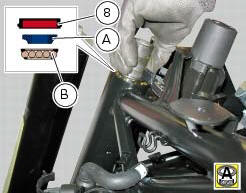
Grease the nut (12).
Tighten the steering shaft nut (12) by hand until it seats against the sealing ring (8).
Fit service bush no. 88713.1058 To the steering shaft nut (12) and fit the torque wrench to the bush.
Tighten the adjuster ring nut (12) to a torque of 30 nm +/-5% (sect. 3 - 3, Frame torque settings).
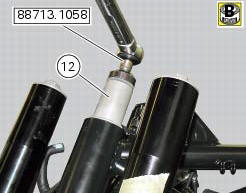
Fit the steering head (2) on the steering head nut (12), aligning the fork leg bores with the corresponding bores on the bottom yoke. Relocate the fork legs as described in section 7 - 10.1, Refitting the front forks.
Grease the screw (3).
Tighten the screw (3) on the steering head to a torque of 24 nm +/-5% (sect. 3 - 3, Frame torque settings).
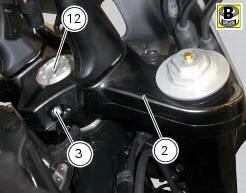
Refit the cable grommet (p) on the steering head and tightening the screws (v) to a torque of 8 nm +/-10% (sect. 3 - 3, Frame torque settings).
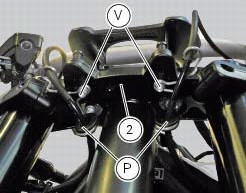
Mount the front support (24) on the right support (23) and the front splashguard (22) on the left support (21), inserting the splashguard pins (p) into the holes in the supports.
Note
For the supports (21), (23) and (24) to be installed correctly, the pins (p) must be fully out at the side opposite to insertion site.
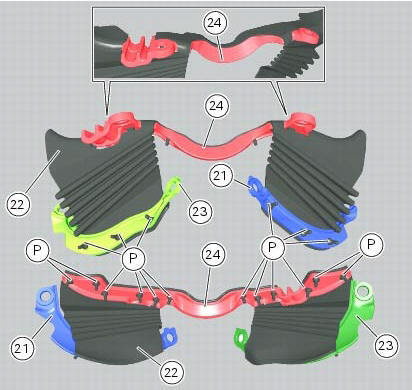
Position the front speed cable (g) and the brake hose (h) in the suitable seats provided by the front support (j) of the splashguard (22) as shown.
Note
To position the brake hose (h) correctly, insert collar (k) of rubber (l) into the guides (m) on the front support (j).
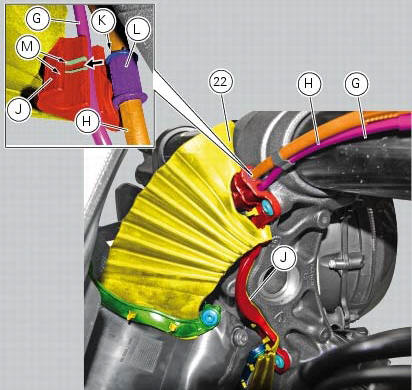
Place the front support (24) of the splashguard (22) on the bottom yoke (15) by tightening the screws (19) to a torque of 4 nm +/- 10% (sect. 3 - 3, Frame torque settings).
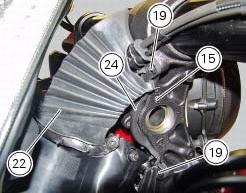
Fix supports (21) and (23) of the splashguard (22) to the air conveyors (t) by tightening the screws (19) to a torque of 4 nm +/- 10% (sect. 3 - 3, Frame torque settings).
Operations

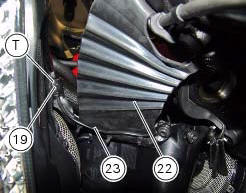

 Removal of the steering head components
Removal of the steering head components
Note
All parts fitted to the top and bottom yokes, including the wiring and
control cables, can remain on the motorcycle
provided they do not hinder the following operations.
Loosen the screw ...
 Rear shock absorber assembly
Rear shock absorber assembly
Special screw
Screw
Nut
Grub screw
Bush (right)
Bush (left)
Screw
Sealing ring
Roller bearing
Linkage (left)
Shock absorber (rear)
Linkage (right)
Spacer
Special screw ...
Other materials:
Suspensions
Front
Hydraulic upside-down fork provided with external adjusters
for rebound and compression damping and preload (for inner
springs of fork legs).
Stanchion diameter:
50 mm, coated.
Rear wheel travel:
120 mm
Rear
The shock absorber is adjustable for rebound and
compression, with remot ...
Reassembling the front footrest brackets
To reassemble the brackets (6) and (21) carry out the removal procedure in
the reverse order; tighten the screws (7) to a
torque of 25 nm +/- 10% (sect. 3 - 3, Frame torque settings).
...
Removal of the cooling system hoses and unions
Loosen the clips (21) that secure the radiator/thermostat sleeve (40) and the
radiator/plug sleeve (24) to the water
radiators.
Loosen clips (25) and (43) that secure the breather pipe (26) to the
radiator/plug sleeve (24) and to the left radiator.
Loosen the clips (34) securi ...